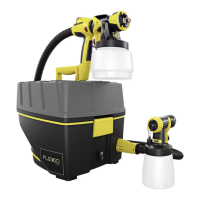GB
31
W 890 Flexio
Fig. 12 A = vertical at jet
for horizontal surfaces
Fig. 12 B = horizontal at jet
for vertical surfaces
Use the red adjustment lever to also switch between a wide
( ) and a narrow ( ) spray jet.
16. Spray Technique
i
The spray result depends heavily on the smoothness and cleanliness of the
surface to be sprayed. Therefore the surface should be carefully prepared and
kept free of dust.
•
Cover all surfaces not to be sprayed.
•
Cover screw threads or similar parts of the target object.
i
Important: Start at the edge of the area to be sprayed. Start the spray
movement rst of all, and then press the trigger. Avoid interruptions
within the area to be sprayed.
•
The spray movement should come from the arm, not just from the wrist. This ensures that
a uniform distance is maintained between the spray gun and the spray surface during
the spray operation. Select a distance of 5 - 15 cm, depending on the desired spray jet
width. When you are using interior wall paint, the distance should be about 20-30 cm
(approx. one stirring rod in length).
Fig. 13 A/ 13 B: CORRECT Even distance to the object.
Fig. 13 B:
INCORRECT An uneven distance will result in uneven paint
application.
•
Move the spray gun evenly cross-wise or up-and-down, depending on the spray
pattern setting.
•
An even movement of the spray gun results in an even surface quality.
•
When coating material builds up on the nozzle and air cap, clean both parts with a
solvent or water.
i
"Cross spray" when using paint with a poor covering capacity or if the
surface is highly absorbent (Fig. 14).
i
Interior wall paint in strong colour shades should be applied at least twice
(allow rst paint coat to dry rst). This will ensure good coverage.

